|
|
Gongs
In the Malaysian Language the word “Gong” describes every kind of percussion instrument. The western music scientists use the word Gong only for a round bronze plate, with or without rim, which is to be hung up and struck.
The gong is a symbol of union, the origin of man. That may be the reason why we get such a deeply fulfilling feeling while listening to a gong. Its mighty sonorous sound waves remind us of the hidden cosmic vastness inside ourselves.
The look, the material and the sound of the gongs vary according to the countries of their origin. Traditionally the gongs from Bali, for example, are hammered out of a metal compound. In the west gongs are usually chased from rolled bronze plates. In Burma, Thailand, Java and Bali there are gongs with a hump in their centre. They are tuned exactly to very clear tones, so they may be played with other instruments.
No matter in which way they are produced, the skill, the experience and the intuition of the gong maker finally determine the result of the sound.
Meanwhile the so-called planet gongs have become quite popular; their tones correspond to frequencies of the planets according to instructions by Hans Cousto. In some way they make the music of the spheres audible.
Here we present some well-known types. In general one can say that the sound is more powerful and deeper the larger a gong is. Smaller gongs are quite handy and easy to carry. Their light sound has a good signal effect so that is heard easily in background noise, as is the case in school classes.
Some of the most popular Chinese Gongs:
• Tam-Tam or Chao Lo: narrow bent rim, hammered by hand with a brass ring in the centre, rich in overtones and very dynamic
• Acoustic Gong: related to the Tam-Tam in construction and look but smaller; with clear long lasting tones. Sold separately or in a chromatically tuned set, from c´-c´´
• Feng Lo, the Wind Gong: a thin polished metal plate without rim; explosive rich sound that dies away faster than that of the Chao Gong
• Double Light Gong: Wind Gong with a bent rim; the sound is as powerful but lasts longer due to the rim
• Xiang Jai: Shaman Gong with broad rim and engraved rhombic design on the front; mystically pulsating sound rich in overtones
• Thai Gong: a humped gong from Thailand with a clear and warm timbre; beautifully decorated with ornaments
• Chieng: Vietnamese hump gong with delicate dragon design; lightweight and small
All the gongs are sold with a striker (wooden handle with textile head). Other types of strikers are sold separately.
On request we offer stands for gongs: from wood or rattan for smaller gongs or metal ones adjustable in height for the bigger Gongs.
 |

GOCH100 Tam-Tam or Chao |
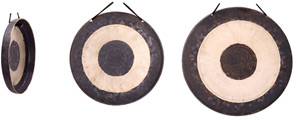
GOAC100 Acoustic |
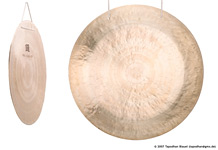
GOFE100 Feng Gong |
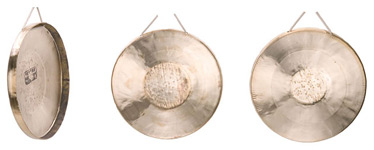
GODL100 Double Light Gong |
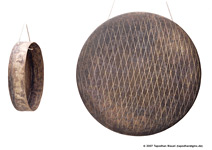
GOXJ100 Xiang-Jai |
 |
Gong Stands
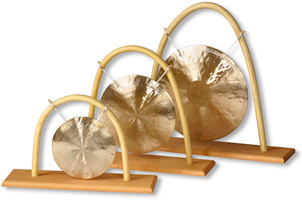
GOST100
Round, Rattan on beech, from 15 to 25cm diameter |
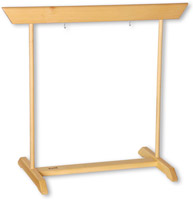
GOST200
Beech, from 30 to 55cm diameter |
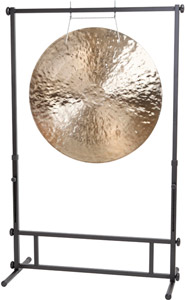
GOST300
Metal, adjustable in height, easy to assemble and dismantle, from 55cm diameter up |
 |
Yun
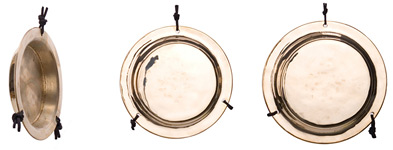
GOYU100 |
The Yun Gong is a flat golden metal plate from China. It can be hung up in a frame, as it has three holes for cords. These sound plates are precisely tuned but have a short sound. Therefore they are ideal for melodic play. The Yun Gongs are tuned in chromatic order with a range from C´´ to B´´.
 |
Thai Gong
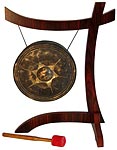
GOTH202 0202 |
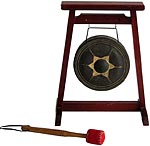
GOTH204 0204 |
 |
Singing Bowls
Nowadays there is almost no one who has not heard of a singing bowl. And those who have heard them are enthusiastic, fascinated and charmed. Singing bowls are magical sounding objects whose history is as secret, as mysterious as their sound. But this is where their magic comes from. There are books like “Song of silence” by David Lindner or “Singing Bowls” by E.R. Jansen where the authors sincerely and extensively tried to illumine us on the origin of singing bowls, and to collect all the information. However it is still buried in oblivion how and when and for what purpose the bowls were made. Only a few monks of Tibet really know about them and even they rarely give explanations. Anyway, Tibet is considered to be the country of origin of the singing bowl and from there they spread to India, Nepal, China and Japan.
Nevertheless singing bowls have taken a triumphant advance around the (musical) globe. You will find the fascinating singing bowls everywhere – be it in New Age trade, music therapy, world music or in kindergartens and schools.
As the demand is much higher than the supply, singing bowls nowadays are produced in factories. This is done in a traditional extensive way based on the old skills, especially in countries like Nepal and India. But the hope of getting a really old singing bowl is almost next to nothing. Fortunately the quality of new made singing bowls meets high demands.
Manufacturers in this line always try to make a good choice and invest a lot of time and energy in it. Some of them even run their own factories in Asia in order to fulfil the increasing demand.
Tuned singing bowls are a speciality amongst the bowls that are not tuned while being produced but carefully measured and chosen by the dealer. Generally singing bowls can be subdivided in following groups:
• Old Tibetan bowls (rarely found)
• New bowls from India, Nepal and Assam (handmade or mechanically produced)
• Mechanically made singing bowls from Japan (with an amazingly pure sound and a high aesthetic value)
• Crystal bowls (made from Quartz crystal, actually a by-product of the computer industry)
• Planet singing bowls (the tuning of handmade singing bowls is measured exactly)
• Singing bowls in the form of Temple Bells (a newly developed type)
Singing bowls can be played by striking them with a suitable striker or by rubbing the rim. The latter needs a bit of practice in order to create a sustained tone and without creating disturbing sounds. The strikers are made from wood, some of them are wrapped with rubber or leather at one end which enables different grades of sound. For aesthetic purposes, people like to place their singing bowl on a beautifully decorated cushion. For playing the bowl is placed on the flat palm.
Let yourself be attracted by the great variety of this melodious magic. With patience and lots of feeling you will find the singing bowl that suits you best.

|
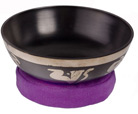
KSDS100
Dharmsala
Dharmsala: flat open bowl, black with golden characters, thin sides, deep tone, low budget |

KSMA100
Mani
Mani: small bowl with plain brass-coloured surface, low budget |
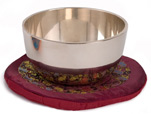
KSNI100
Nilima
Nilima: tall even bowl with golden polished surface, very clear tone |

KSUP100
Upana
Upana: small and flat; polished black surface and a very pure sound |
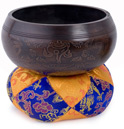
KSLU100
Lumbini
Lumbini: tall rounded bowl with a broad rim, brown colour with engraved ornaments, clear sound |

KSDI100
Dibya
Dibya: high rim, polished copper surface; clear sound
|
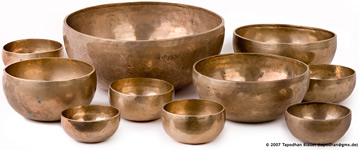
KSTI100
Handmade in the Tibetan style Handmade bowls from India are made from an alloy of different metals; they have a high rim, thin sides, a living sound rich in overtones. |
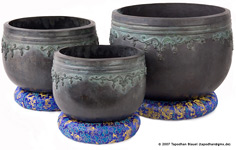
KSQN100
Qin
Qin: noble looking Chinese model with antique ornaments; light greenish patina on the surface, subtle long lasting sound |
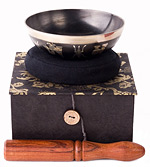

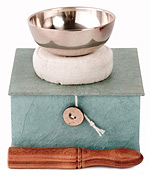
KSGS100
Singing Bowl gift sets
Gift set: small polished bowl with a colourful cushion and a turned wooden striker in a corresponding gift box |
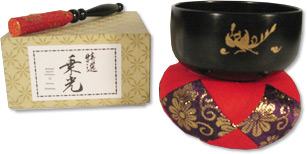
Taiho KSTA100
Taiho: noble black Japanese bowl with a dragon design; thin sides but quite heavy, pure harmonious sound |
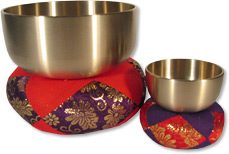
Dharma KSDH100
Dharma: little Japanese bowl with silver-golden surface; very delicate singing sound, low in price |

KSKK100
Crystal Singing Bowls |
 |
|
Copyright © Gandharva Loka |

